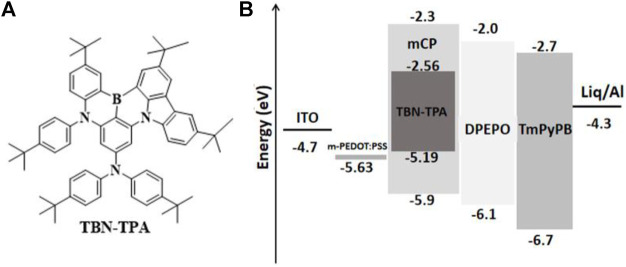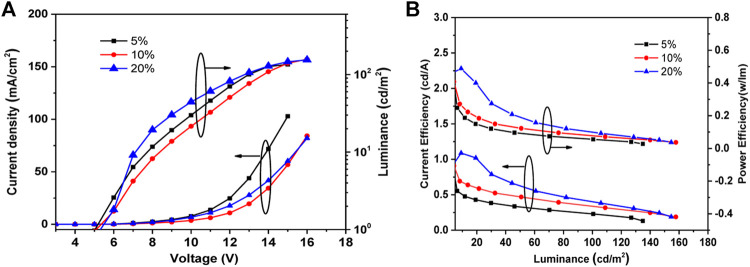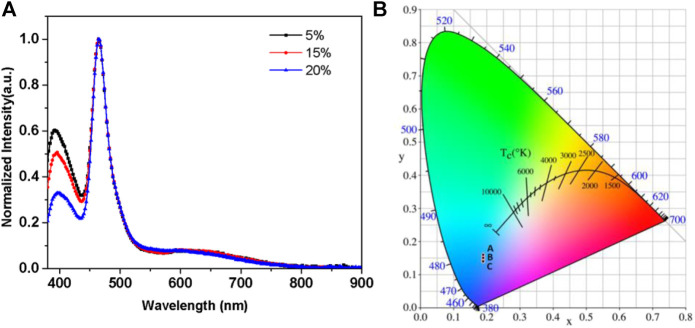Abstract
There is a need to satisfy the high color purity requirement of display technology with a simply fabricated process. Herein, solution-processed blue thermally activated delayed fluorescence organic light-emitting diodes (OLEDs) with a narrow spectrum with a full width at half maximum (FWHM) of 32 nm and y color coordinate below 0.2 are demonstrated by employing a molecule containing boron and nitrogen atoms (TBN-TPA) as the guest emitter in the emissive layer. The opposite resonance positions of B-N atoms of TBN-TPA endows a multi-resonance effect, leading to high color purity.
Keywords: organic light-emitting diodes, thermally activated delayed fluorescence, solution process, narrow bandwidth, pure blue
Introduction
Solution-processed organic light-emitting diodes (s-OLEDs) are regarded as one of the most fascinating and competitive technologies for large-area and low-cost display panels and solid-state lighting sources (Müller et al., 2003; So et al., 2008; Zhu et al., 2011; Sasabe and Kido, 2013; Zheng et al., 2013; Xu et al., 2017a; Xu et al., 2019; Wang et al., 2020; Xu et al., 2021). Modern electronic products can be easily manufactured by ink-jet printing or ‘roll-to-roll’ coating methods, akin to how newspapers are produced. However, the current state-of-the-art OLEDs rely on physical vapor deposition, which leads to high manufacturing costs and energy consumption (Kololuoma et al., 2004; Mauthner et al., 2008; Sandström et al., 2012; Xu et al., 2016). The invention and application of thermally activated delayed fluorescence (TADF) compounds as the emitters without precious metals (e.g., iridium, platinum, rhenium, etc.), further facilitate more cost-effective OLED technology (Uoyama et al., 2012; Huang et al., 2018; Xu et al., 2018). Blue color plays an important role as one of the three primary colors of OLEDs. A novel concept for multi-resonance TADF (MR-TADF) was proposed by Hatakeyama et al. in 2016. The reported TADF emitters show particular HOMO and LUMO distributions due to the rigid framework of boron and nitrogen (B-N) atoms’ array, leading to the MR effect. This MR effect enhances the oscillating strength between S1 and S0, generating a narrow full-width-at-half-maximum (FWHM) of 28 nm, showing unexpected high color purity in TADF species (Hatakeyama et al., 2016). Then highly efficient blue MR-TADF molecules were developed, showing an extremely high external quantum efficiency (EQE) of up to 34.4% and a narrow FWHM of 14 nm (Kondo et al., 2019). However, blue MR-TADF materials with high color purity are rarely applied in s-OLED. Therefore, it is attractive to investigate blue MR-TADF materials aiming for a solution process.
In this paper, solution-processed blue TADF OLEDs with a narrow bandwidth have been demonstrated by applying a molecule TBN-TPA (Liang et al., 2018) containing boron and nitrogen (B-N) atoms. Our results provided new understanding of the electroluminescence of blue MR-TADF emitter, which would be beneficial to the development of solution-processed OLED technology for high-performance displays.
Experiment Details
The chemical structures of TBN-TPA and the energy level diagram of the device are exhibited in Figures 1A,B, respectively. TBN-TPA was synthesized according to the literature (Liang et al., 2018). 1,3-bis(9H-carbazol-9-yl)benzene (mCP), 8-hydroxyquinolinolatolithium (Liq), bis [2-(diphenyl-phosphino)phenyl]ether oxide (DPEPO), 1,3,5-tri [(3-pyridyl)-phen-3-yl] benzene (TmPyPB), and 8-hydroxyquino -linolatolithium (Liq) were purchased from Xi'an Polymer Light Technology Corporation and used as received.
FIGURE 1.
(A) The chemical structure of TBN-TPA. (B) Energy level diagrams of the devices.
All the devices were fabricated on the glass substrate patterned with the conducting indium-tin-oxide (ITO) anode with a sheet resistance lower than 20 Ω/square. Acetone and ethanol were consecutively used to clean the ITO substrates in an ultrasonic bath. The substrates were further dried with N2 flow. After 20 min of ultraviolet light-ozone treatment, a modified PEDOT: PSS (m-PEDOT:PSS) was spin-coated onto the ITO surface at 4,000 rpm (Xiang et al., 2019). Afterward, the substrate was baked at 120°C for 10 min in a glove box. TBN-TPA and mCP, respectively as the guest and host of the emissive material layer (EML), sufficiently dissolved in chlorobenzene solvent. Later, the corresponding EML was spin coated at 1,000 rpm and then accompanied with a 50°C baking process for 10 min. The corresponding functional materials and aluminum cathode were vacuum deposited step by step under 10−5 mbar. The actual device area defined by the crossover of the ITO anode and the Al cathode was 2 mm × 2.2 mm.
In this study, the OLEDs using the conventional mCP host were fabricated while TBN-TPA with the B-N core-structure containing a peripheral electron-donating carbazole unit was applied as the blue guest. The structure of the devices is ITO/m-PEDOT:PSS/TBN-TPA (5 wt%, 10 wt%, and 20 wt%): mCP/DPEPO (10 nm)/TmPyPB (50 nm)/Liq (1 nm)/Al (100 nm). The energy level diagram of the device is shown in Figure 1B. m-PEDOT:PSS acts as the hole injection layer (HIL) (Xiang et al., 2019). DPEPO serves as the exciton blocking layer with a high triplet energy level over 3.0 eV, which helps to confine the excitons in the emitting layer (Xu et al., 2017b). Liq and TmPyPB are used as the electron injection layer (EIL) and electron transporting layer (ETL), respectively.
The current density-voltage-luminance (J-V-L), the current efficiency-luminance -power efficiency (CE-L-PE) characteristics, the color coordinates, and the electroluminescence (EL) spectra of the devices were measured and recorded by a computer-controlled Keithley 2,400 Source Meter Unit and Photo Research PR735 spectrometer. All measurements were carried out at room temperature in ambient air.
Results and Discussion
The devices A, B, and C were fabricated and tested in one flow doping with different TBN-TPA concentrations i.e., 5 wt%, 10 wt%, and 20 wt%, respectively. The J-V-L and CE-L-PE characteristics are shown in Figures 2A,B, respectively. The device performances of the blue TADF OLEDs with different doping concentrations of TBN-TPA are summarized in Table 1.
FIGURE 2.
(A) Current density-voltage-luminance and (B) current efficiency-luminance-power efficiency characteristics of the devices.
TABLE 1.
The EL characteristics of blue TADF OLEDs.
| Device | Processing/Host | Von a [V] | ELpeak [nm] | CEmax b [cd A−1] | FWHM c [nm] | PEmax d [lm W−1] | EQEmax e [%] | CIE f [x, y] |
|---|---|---|---|---|---|---|---|---|
| A | Solution/mCP | 4.5 | 464 | 0.55 | 32 | 0.25 | 0.66 | 0.19, 0.14 |
| B | Solution/mCP | 4.8 | 464 | 0.91 | 32 | 0.41 | 1.03 | 0.19, 0.15 |
| C | Solution/mCP | 5.0 | 464 | 1.08 | 32 | 0.49 | 1.08 | 0.19, 0.19 |
The turn-on voltage recorded at a brightness of 1 cd m−2.
Maximum value 2 of current efficiency.
Full-width-at-half-maximum of the EL spectrum.
Power efficiency.
External quantum efficiency.
Commission Internationale de l’Eclairage (CIE) coordinates.
The turn-on voltage of the s-OLED with TBN-TPA depended on the increasing concentration of TBN-TPA. Under the same voltage, the s-OLED with higher concentrations of TBN-TPA as emitter showed lower current density (shown in Figure 2A). In contrast, the current efficiency (CE), power efficiency (PE), and EQE increased as the doping concentration increased, shown in Figure 2B and Table 1. The device with 20 wt% TBN-TPA depicted the maximum EQEs of 1.08% with narrow FWHM of 32 nm. The performances of OLEDs with solution-processed TBN-TPA as blue TADF emitter are much lower than those of the devices with physical vapor deposition, which may be ascribed to the unsatisfactory film quality fabricated by spin-coating (Liang et al., 2018; Tang et al., 2020). Solution-processed organic thin films are generally of a lower quality than those fabricated by physical vapor deposition. More morphological defects could be induced and thus deteriorate charge transport properties and radiative decays in the solution-processed devices. Therefore, it is reasonable that solution-processed OLEDs generally exhibit lower EQEs compared with that of vapor deposition OLEDs using the same emitter despite the simple fabrication processing (Diao et al., 2014). Therefore, more effort should be devoted to device engineering.
The EL spectrum and the chromaticity coordinates of the devices with TBN-TPA are shown in Figures 3A,B. The two peaks of the normalized EL spectra of the devices could be determined, which originated from the blue TADF emitter TBN-TPA and host mCP, respectively, peaking at 464 and 396 nm (shown in Figure 3A). This is attributed to the inefficient host-guest energy transfer. As for the chromaticity coordinates of the devices, the CIE (x,y) coordinates were slightly changed with the y value below 0.2 in Figure 3B. As the concentration of TBN-TPA increased from 5 to 20%, the residual emission of the host mCP was gradually quenched by TBN-TPA, which resulted in relatively higher EQEs, shown in Table 1. Meanwhile, there exists some interfacial exciplex which accounts for the emission band in the region of 600–700 nm.
FIGURE 3.
(A) The normalized EL spectra of devices and (B) the chromaticity coordinates of devices.
Conclusion
In summary, we succeeded in employing blue TADF dye with the narrow bandwidth in solution-processed OLED as the emitter to realize high color purity. This technical route shows high value in the development of solution-processed OLED display technology.
Acknowledgments
The authors would like to express their special gratitude to Prof. Xiaoyuan Hou, Prof. Chuluo Yang, and Prof. Youxuan Zheng for their support and assistance in my research.
Data Availability Statement
The raw data supporting the conclusions of this article will be made available by the authors, without undue reservation.
Author Contributions
TX conceived, fabricated, and characterized OLED. XL synthesized blue TADF materials. GX directed and supervised the project.
Funding
This work was supported by the National Natural Science Foundation of China (No. 51903160, 51803125, and 91833304), China Postdoctoral Science Foundation (2019M663027), Open Project Funding of Jiangsu Key Laboratory for Carbon-Based Functional Materials and Devices, Soochow University, China. (KJS 1908), and Open Project Funding of State Key Laboratory of Surface Physics and Department of Physics, Fudan University, China. (KF2019_13).
Conflict of Interest
The authors declare that the research was conducted in the absence of any commercial or financial relationships that could be construed as a potential conflict of interest.
References
- Diao Y., Shaw L., Bao Z., Mannsfeld S. C. B. (2014). Morphology Control Strategies for Solution-Processed Organic Semiconductor Thin Films. Energy Environ. Sci. 7, 2145–2159. 10.1039/c4ee00688g [DOI] [Google Scholar]
- Hatakeyama T., Shiren K., Nakajima K., Nomura S., Nakatsuka S., Kinoshita K., et al. (2016). Ultrapure Blue Thermally Activated Delayed Fluorescence Molecules: Efficient HOMO-LUMO Separation by the Multiple Resonance Effect. Adv. Mater. 28, 2777–2781. 10.1002/adma.201505491 [DOI] [PubMed] [Google Scholar]
- Huang T., Jiang W., Duan L. (2018). Recent Progress in Solution Processable TADF Materials for Organic Light-Emitting Diodes. J. Mater. Chem. C. 6, 5577–5596. 10.1039/c8tc01139g [DOI] [Google Scholar]
- Kololuoma T., Tuomikoski M., Makela T., Heilmann J., Haring T., Kallioinen J., et al. (2004). Towards Roll-To-Roll Fabrication of Electronics, Optics, and Optoelectronics for Smart and Intelligent Packaging. SPIE. 10.1117/12.535456 [DOI] [Google Scholar]
- Kondo Y., Yoshiura K., Kitera S., Nishi H., Oda S., Gotoh H., et al. (2019). Narrowband Deep-Blue Organic Light-Emitting Diode Featuring an Organoboron-Based Emitter. Nat. Photon. 13, 678–682. 10.1038/s41566-019-0476-5 [DOI] [Google Scholar]
- Liang X., Yan Z.-P., Han H.-B., Wu Z.-G., Zheng Y.-X., Meng H., et al. (2018). Peripheral Amplification of Multi-Resonance Induced Thermally Activated Delayed Fluorescence for Highly Efficient OLEDs. Angew. Chem. Int. Ed. 57, 11316–11320. 10.1002/anie.201806323 [DOI] [PubMed] [Google Scholar]
- Mauthner G., Landfester K., Köck A., Brückl H., Kast M., Stepper C., et al. (2008). Inkjet Printed Surface Cell Light-Emitting Devices from a Water-Based Polymer Dispersion. Org. Elect. 9, 164–170. 10.1016/j.orgel.2007.10.007 [DOI] [Google Scholar]
- Müller C. D., Falcou A., Reckefuss N., Rojahn M., Wiederhirn V., Rudati P., et al. (2003). Multi-colour Organic Light-Emitting Displays by Solution Processing. Nature 421, 829–833. 10.1038/nature01390 [DOI] [PubMed] [Google Scholar]
- Sandström A., Dam H. F., Krebs F. C., Edman L. (2012). Ambient Fabrication of Flexible and Large-Area Organic Light-Emitting Devices Using Slot-Die Coating. Nat. Commun. 3, 1002. 10.1038/ncomms2002 [DOI] [PMC free article] [PubMed] [Google Scholar]
- Sasabe H., Kido J. (2013). Development of High Performance OLEDs for General Lighting. J. Mater. Chem. C. 1, 1699–1707. 10.1039/c2tc00584k [DOI] [Google Scholar]
- So F., Kido J., Burrows P. (2008). Organic Light-Emitting Devices for Solid-State Lighting. MRS Bull. 33, 663–669. 10.1557/mrs2008.137 [DOI] [Google Scholar]
- Tang Y., Xie G., Liang X., Zheng Y.-X., Yang C. (2020). Organic and Quantum-Dot Hybrid White LEDs Using a Narrow Bandwidth Blue TADF Emitter. J. Mater. Chem. C. 8, 10831–10836. 10.1039/d0tc01942a [DOI] [Google Scholar]
- Uoyama H., Goushi K., Shizu K., Nomura H., Adachi C. (2012). Highly Efficient Organic Light-Emitting Diodes from Delayed Fluorescence. Nature 492, 234–238. 10.1038/nature11687 [DOI] [PubMed] [Google Scholar]
- Wang S., Zhang H., Zhang B., Xie Z., Wong W.-Y. (2020). Towards High-Power-Efficiency Solution-Processed OLEDs: Material and Device Perspectives. Mater. Sci. Eng. R: Rep. 140, 100547. 10.1016/j.mser.2020.100547 [DOI] [Google Scholar]
- Xiang Y., Xie G., Li Q., Xue L., Xu Q., Zhu J., et al. (2019). Feasible Modification of PEDOT:PSS by Poly(4-Styrenesulfonic Acid): A Universal Method to Double the Efficiencies for Solution-Processed Organic Light-Emitting Devices. ACS Appl. Mater. Inter. 11, 29105–29112. 10.1021/acsami.9b09346 [DOI] [PubMed] [Google Scholar]
- Xu T., Yan L., Miao J., Hu Z., Shao S., Li A., et al. (2016). Unlocking the Potential of Diketopyrrolopyrrole-Based Solar Cells by a Pre-solvent Annealing Method in All-Solution Processing. RSC Adv. 6, 53587–53595. 10.1039/c6ra09770g [DOI] [Google Scholar]
- Xu T., Yi R., Zhu C., Lin M. (2021). Simple-Structured OLEDs Incorporating Undoped Phosphorescent Emitters within Non-exciplex Forming Interfaces: Towards Ultraslow Efficiency Roll-Off and Low Driving Voltage for Indoor R/G/B Illumination, 8. 10.3389/fchem.2020.630687 [DOI] [PMC free article] [PubMed] [Google Scholar]
- Xu T., Zhang Y.-X., Huang C.-C., Zhou J.-G., Fung M.-K., Meng H. (2019). Highly Simplified Blue Phosphorescent Organic Light-Emitting Diodes Incorporating Exciplex-Forming Co-host Assisting Energy Transfer. J. Lumin. 206, 554–559. 10.1016/j.jlumin.2018.10.007 [DOI] [Google Scholar]
- Xu T., Zhang Y.-X., Murtaza I., Meng H. (2017a). P-170: Organic Light-Emitting Diodes Incorporating a Novel Exciplex-Forming Host: A Synergistic Strategy to Design Highly Simplified OLEDs for Application. OLEDs Appl. 48, 1915–1918. 10.1002/sdtp.12004 [DOI] [Google Scholar]
- Xu T., Zhang Y.-X., Wang B., Huang C.-C., Murtaza I., Meng H., et al. (2017b). Highly Simplified Reddish Orange Phosphorescent Organic Light-Emitting Diodes Incorporating a Novel Carrier- and Exciton-Confining Spiro-Exciplex-Forming Host for Reduced Efficiency Roll-Off. ACS Appl. Mater. Inter. 9, 2701–2710. 10.1021/acsami.6b13077 [DOI] [PubMed] [Google Scholar]
- Xu T., Zhou J.-G., Fung M.-K., Meng H. (2018). Simplified Efficient Warm White Tandem Organic Light-Emitting Devices by Ultrathin Emitters Using Energy Transfer from Exciplexes. Org. Elect. 63, 369–375. 10.1016/j.orgel.2018.09.026 [DOI] [Google Scholar]
- Zheng H., Zheng Y., Liu N., Ai N., Wang Q., Wu S., et al. (2013). All-solution Processed Polymer Light-Emitting Diode Displays. Nat. Commun. 4, 1971. 10.1038/ncomms2971 [DOI] [PubMed] [Google Scholar]
- Zhu X.-H., Peng J., Cao Y., Roncali J. (2011). Solution-processable Single-Material Molecular Emitters for Organic Light-Emitting Devices. Chem. Soc. Rev. 40, 3509–3524. 10.1039/c1cs15016b [DOI] [PubMed] [Google Scholar]
Associated Data
This section collects any data citations, data availability statements, or supplementary materials included in this article.
Data Availability Statement
The raw data supporting the conclusions of this article will be made available by the authors, without undue reservation.





